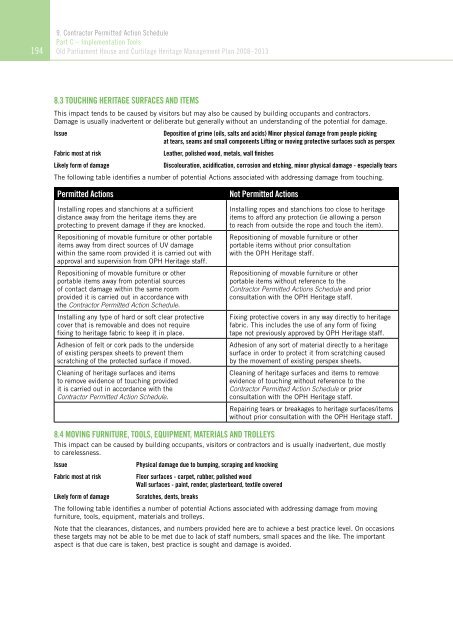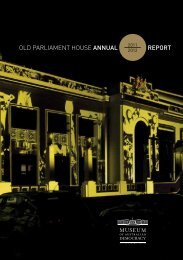OLD PARLIAMENT HOUSE AND CURTILAGE HERITAGE MANAGEMENT PLAN 2008–2013
Heritage Management Plan 2008-2013 - Museum of Australian ...
Heritage Management Plan 2008-2013 - Museum of Australian ...
- No tags were found...
You also want an ePaper? Increase the reach of your titles
YUMPU automatically turns print PDFs into web optimized ePapers that Google loves.
9. Contractor Permitted Action Schedule<br />
Part C – Implementation Tools<br />
194 Old Parliament House and Curtilage Heritage Management Plan <strong>2008–2013</strong><br />
8.3 TOUCHING <strong>HERITAGE</strong> SURFACES <strong>AND</strong> ITEMS<br />
This impact tends to be caused by visitors but may also be caused by building occupants and contractors.<br />
Damage is usually inadvertent or deliberate but generally without an understanding of the potential for damage.<br />
Issue<br />
Deposition of grime (oils, salts and acids) Minor physical damage from people picking<br />
at tears, seams and small components Lifting or moving protective surfaces such as perspex<br />
Fabric most at risk<br />
Leather, polished wood, metals, wall finishes<br />
Likely form of damage<br />
Discolouration, acidification, corrosion and etching, minor physical damage - especially tears<br />
The following table identifies a number of potential Actions associated with addressing damage from touching.<br />
Permitted Actions<br />
Installing ropes and stanchions at a sufficient<br />
distance away from the heritage items they are<br />
protecting to prevent damage if they are knocked.<br />
Repositioning of movable furniture or other portable<br />
items away from direct sources of UV damage<br />
within the same room provided it is carried out with<br />
approval and supervision from OPH Heritage staff.<br />
Repositioning of movable furniture or other<br />
portable items away from potential sources<br />
of contact damage within the same room<br />
provided it is carried out in accordance with<br />
the Contractor Permitted Action Schedule.<br />
Installing any type of hard or soft clear protective<br />
cover that is removable and does not require<br />
fixing to heritage fabric to keep it in place.<br />
Adhesion of felt or cork pads to the underside<br />
of existing perspex sheets to prevent them<br />
scratching of the protected surface if moved.<br />
Cleaning of heritage surfaces and items<br />
to remove evidence of touching provided<br />
it is carried out in accordance with the<br />
Contractor Permitted Action Schedule.<br />
Not Permitted Actions<br />
Installing ropes and stanchions too close to heritage<br />
items to afford any protection (ie allowing a person<br />
to reach from outside the rope and touch the item).<br />
Repositioning of movable furniture or other<br />
portable items without prior consultation<br />
with the OPH Heritage staff.<br />
Repositioning of movable furniture or other<br />
portable items without reference to the<br />
Contractor Permitted Actions Schedule and prior<br />
consultation with the OPH Heritage staff.<br />
Fixing protective covers in any way directly to heritage<br />
fabric. This includes the use of any form of fixing<br />
tape not previously approved by OPH Heritage staff.<br />
Adhesion of any sort of material directly to a heritage<br />
surface in order to protect it from scratching caused<br />
by the movement of existing perspex sheets.<br />
Cleaning of heritage surfaces and items to remove<br />
evidence of touching without reference to the<br />
Contractor Permitted Action Schedule or prior<br />
consultation with the OPH Heritage staff.<br />
Repairing tears or breakages to heritage surfaces/items<br />
without prior consultation with the OPH Heritage staff.<br />
8.4 MOVING FURNITURE, TOOLS, EQUIPMENT, MATERIALS <strong>AND</strong> TROLLEYS<br />
This impact can be caused by building occupants, visitors or contractors and is usually inadvertent, due mostly<br />
to carelessness.<br />
Issue<br />
Fabric most at risk<br />
Likely form of damage<br />
Physical damage due to bumping, scraping and knocking<br />
Floor surfaces - carpet, rubber, polished wood<br />
Wall surfaces - paint, render, plasterboard, textile covered<br />
Scratches, dents, breaks<br />
The following table identifies a number of potential Actions associated with addressing damage from moving<br />
furniture, tools, equipment, materials and trolleys.<br />
Note that the clearances, distances, and numbers provided here are to achieve a best practice level. On occasions<br />
these targets may not be able to be met due to lack of staff numbers, small spaces and the like. The important<br />
aspect is that due care is taken, best practice is sought and damage is avoided.




